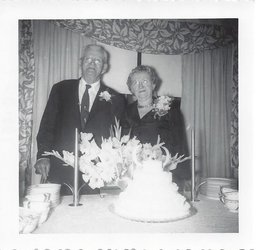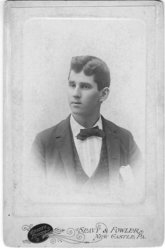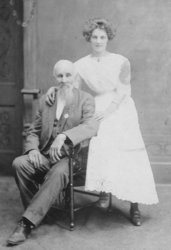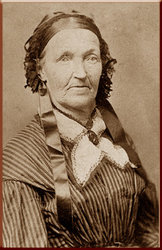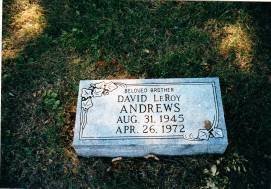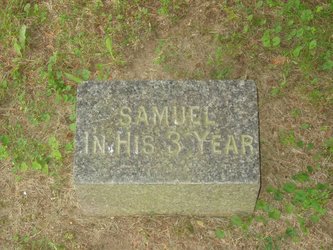| About Our Andrews Family History
Please sign in to see more. Hills in the Civil War
John Hill served in the 52nd Illinois Volunteer Infantry Regiment, as did Orry Turner (258).
John enlisted 2 November 1861 in Chicago in Company C, 52nd Regiment Illinois Volunteer Infantry. He is described in muster documents as having brown eyes, red hair, a sandy complexion, height 5 feet 11 1/2 inches and by occupation a farmer. Orry enlisted 17 September 1861 at Lamoille, Illinois in Company B of the 52nd Illinois.
The 52nd Illinois was formed at Geneva, Kane County, Illinois and mustered into the US Army 19 November 1861 by Col J.S. Wilson. On 28 November it moved to Benton Barracks, St. Louis, MO were it received military training. On 8 December it moved to St. Joseph, MO. On 17 February 1862, the 52nd Illinois arrived at Fort Donelson the day following the forts surrender. On 18 February 1862, the 52nd escorted prisoners to Chicago.
On 6-7 April 1862, the 52nd Illinois was involved in the battle of Shiloh, playing a prominent part resulting in 170 casualties (men killed, wounded or missing). In May 1862, the 52nd took part in the siege of Corinth, May 1862. John was present at these engagements, and on 21 June 1862 was promoted to Corporal. During the battle of Corinth, 3-4 October 1862, the 52nd was heavily engaged, losing 70 men killed and wounded. The 52nd was involved in skirmishes at Iuka and Bear Creek, Alabama during April 1863. John was also present at these times. By orders dated 23 Feb 1863, John was promoted to the rank of Sergeant effective 12 Jan 1863. Orry was also present during these battles.
John reenlisted 25 December 1863 in DeKalb County, Illinois, as a Veteran Volunteer, along with about 3/4 of the regiment, at the rank of Private. He was mustered into US service at Pulaski, Tennessee with an effective date of 19 November 1861, and was promoted to Sergeant effective 31 December 1863. The 52nd Illinois Infantry was remustered 8 January 1864 as a veteran unit.
John received a thirty day furlough on 2 January 1864. He returned home to Crawford County, Pennsylvania. While at home, he came down with small pox (probably contracted enroute) and was unable to travel again until April. He reported to the Provost Marshall in Meadville and was arrested as a straggler for being Absent-Without-Leave, but returned to his unit 18 April 1864. He was taken sick again at Pulaski, Tennessee 29 Apr 1864.
On 3 May 1864 the Atlanta campaign began. On 21 December 1864, the 52nd marched to Savannah, part of the "March to the Sea." On 29 January 1865, the Carolinas campaign began. John was present during this time. On 14 Feb 1865, John was placed on detached service with the Smallpox Hospital, serving with the Ambulance Corps. It was during the "March to the Sea" that Orry's health began to fail. On 1 May 1864, he was transferred to the Twenty-fourth Reserve Regiment in Washington, D.C., where he received his discharge for poor health.
On 11 Mar 1865, John was captured at Antioch Church near Fayetteville in North Carolina, while guarding the Smallpox ambulances. In his own words, he "was taken with a large squad of other prisoners on freight cars, in an inclement season of the year, from Salisbury, North Carolina to Danbury (Danville, Viginia?), and from thence to Libby Prison in Richmond, VA. "We rode on the top of the cars, a cold rain incessantly falling," he later wrote. He was paroled at Aiken's Landing, Virginia on 2 April 1865, the day Union forces entered Richmond, and was sent to Camp Parole, Annapolis, Maryland, reporting there 4 April 1865. He reported to Benton Barracks, St. Louis, Missouri on 12 Apr 1865 where he received a thirty day furlough on 14 April. He returned 13 May and was sent to Camp Butler, Illinois on 22 May and was discharged a short time later. In the meantime, the 52nd had marched to Raleigh on 10 April, and lay at Morrisville during the surrender 26 April of General Joseph Johnson and the Army of Tennessee, effectively ending the war. The veterans of the 52nd, including John, were mustered out 6 July 1865, and received final payment and discharge on 12 July 1865.
Archibald Hill served in the 8th Iowa Volunteer Infantry Regiment. He was living in Kingston, Iowa when he joined the army, a few months short of his thirtieth birthday. He enlisted 20 September 1861 in Company D, 12th Regiment Iowa Volunteer Infantry at Cedar Rapids.
Company D, 12th Iowa was mustered 26 October 1861 for a term of three years at Dubuque, Iowa by CPT E.C. Washington, US Army. At the time of his enlistment, Archibald was 29 years old, had a light complexion, red hair, brown eyes, stood five feet 8 3/4 inches tall, and was a carpenter by occupation.
On 28 November 1861 the 12th Iowa traveled to Benton Barracks, St. Louis, Missouri, along with other Iowa volunteer regiments. There it received military training. After training, the 12th Iowa was sent to Cairo, Illinois, then by steamer to the mouth of the Cumberland River where it camped in the field for the first time, 31 January 1862. On February 5th, the 12th embarked once more on steamboats and landed four miles from Fort Henry where it joined a force intended to attack the fort. Due to the impassible condition of the roads, the troops did not arrive until after the fort's surrender.
On the 12th of February 1862, the 12th Iowa was assigned to Cook's Brigade of Smith's Division and ordered to Gen U.S. Grant's army attacking Fort Donelson, where it arrived the same day. Fort Donelson was nothing but a stockade surrounding log huts, but it sat at the top of a 100 foot bluff commanding a bend in the Cumberland River with cannon, and was manned by 17,500 Confederate troops. The 12th originally lay to the left of the Dover Road and, on the 15th, supported the charge of Colonel Lauman's brigade when the Confederates attempted a breakout. The breakout was contained, trapping the Confederates in the fort. When Simon Bolivar Buckner, acting Confederate commander, asked for terms, Grant replied "No terms except an immediate and unconditional surrender..." Buckner thought the terms "ungenerous and unchivalrous" but accepted, earning Grant the nickname "Unconditional Surrender" Grant.
The second military action for the 12th Iowa was in April. The Union force under Gen U.S. Grant was attacked suddenly, just after dawn on Sunday 6 April 1862 at Pittsburg Landing, Tennessee. The battle later was named for a little church nearby: Shiloh, a Hebrew word meaning a place of peace.
At Shiloh, the 12th Iowa Regiment, under Col J.J. Woods, part of the 1st Brigade under BG Tuttle, 2nd Division under BG W.H.L. Wallace, along with Gen Prentiss' division, fought in the "Hornet's nest" in the center of the Union lines. This group withstood the rebel advance for six hours, with Union forces around them moving to the rear. About 4:30, Wallace attempted to move to the rear under orders; two regiments, the 2nd and 8th Iowa, broke through the encircling rebel lines, but Wallace fell, mortally wounded. The 12th and the 14th Iowa regiments and Prentiss' division were surrounded. At 5:30, having sheltered the Union retreat, they surrendered, 2200 men, including Archibald. The Confederate commander, General Albert Sidney Johnston, was also killed. General Beauregard wired Richmond that he had won a notable victory, but Union reinforcements under Gen Buell arriving on the 7th ensured a final Union victory. The 12th lost 16 killed, 97 wounded and about 400 captured at Shiloh. Shiloh was the bloodiest battle of the war up to that point, causing Grant to be labeled a butcher.
Archibald and the other prisoners taken at Shiloh were initially imprisoned in Corinth, Mississippi.,then taken to Tuscaloosa, Alabama on 16 April then to Montgomery, Alabama on 15 May. Archibald was among the prisoners paroled on 22 May in Montgomery and released at Bellefont Station on 28 May. From there they went to Benton Barracks, Missouri. Archibald left the parole camp about 20 September 1862 and went to Cochranton, PA, where he fell ill. He was reported as sick and unfit for duty by Surgeons Certificate March 1863.
The 12th Iowa reassembled 29 March 1863 at Benton Barracks, and on 9 April was assigned to the 3rd Brigade, 3rd Division, 15th Army Corps commanded by Sherman. The 12th Iowa subsequently participated in the Vicksburg campaign.
On 25 December 1863, along with 297 others, Archibald reenlisted for 3 years and the 12th Iowa was remustered as a veteran unit on 5 January 1864 and given a 30 day furlough on 22 March 1864 at Davenport, Iowa.
On 13-15 July in a battle at Tupelo, Mississippi at which Archibald was apparently present, the 12th lost 64 killed and wounded out of a total brigade loss of 197. On 1 September 1864, Archibald was detailed to the Quarter Master Department, First Division, 16th Army Corps and was sent to the US Army Hospital in Paducah, Kentucky on 19 November 1864. He apparently remained in the hospital until he was furloughed 12 March 1865.
Archibald Fulton Hilland his brother, James Montgomery Hill , served in the Company H, 150th Pennsylvania Volunteer Infantry (Bucktails). Company H, as well as companies C, I and K of this regiment were recruited in Crawford County while companies A, B, E, and F were recruited in Philadelphia, D in Union County and G in McKean. The regiment was formed when these companies rendezvoused at Camp Curtain (the governor of Pennsylvania was Andrew Curtain), near Harrisburg, on 4 September 1862. The regiment, one of the three year regiments, was formed with experienced officers, all from Pennsylvania. Initially, the 150th Regiment was used as guards in Washington, D.C. Company A served throughout the war as Presidential bodyguards. Archibald, in a letter of 13 Oct 1862 to his cousin John Hill (424) with the 52nd Illinois, wrote "We are in the city of Washington guarding an Hospital. We have been here for two weeks, we are on two hours and off six, we do not drill any and therefore we have plenty of time for to write and run around so we are here when our time comes to go on guard."
In February 1863, the 150th moved to Belle Plain, Virginia, somewhat to the north of Fredericksburg. There they were formed into a brigade with the 149th Pennsylvania, and the 143rd Pennsylvania under the command of COL Roy A. Stone. This became the Second Brigade, Third Division, First Corps, Army of the Potomac. On 8 April 1862, Archibald wrote to his sister Jennie [Eliza Jane Hill (384)] from Belle Plain,"We are expecting to move soon, we are ordered to have an extra pare of Shoes I have my first Pare of Shoes to ware, my Boots are midling good yet I have only had them half Soled once, one of them cracked for want of Grease and I had to have it Patched."
Lincoln replaced Ambrose Burnside as commander of the Army of the Potomac with Joseph Hooker on 26 January 1863. On 21 April 1863, the Third Division marched to Port Conway, opposite Port Royal (just south of Fredericksburg) and made a feint of crossing the Rappahannock River, then returned to camp at Belle Plain on the 23rd. On the 27th, George Meade led one wing of the Army, consisting of his own Fifth Corps, plus the 11th and 12th Corps, from Falmouth, opposite Fredericksburg, up the Rappahannock, crossing at Kelly's Ford. Meade with the Fifth Corps then marched toward Chancellorsville, crossing the Rapidan River at Ely's Ford, arriving on 30 April. The 11th and 12th Corps crossed the Rapidan at Germanna Ford, also reaching Chancellorsville on the 30th. Once there, Meade was anxious to press on to fall on Lee's army, still at Fredericksburg. General Slocum, commanding the 12th Corps, however, informed him that he had orders from General Hooker to assume command of all three corps at Chancellorsville and await until the 2nd and 3rd Corps were up. The 2nd Corps crossed the Rappahannock at United States Ford, arriving on 1 May while the 2nd Corps, also crossing at United States Ford, arrived on 2 May. This delay allowed Lee to respond to the Federal turning movement, and he moved toward Chancellorsville, a shorter distance for his army than for the Union army. The First Corps under John Reynolds, including the 150th, made a forced march to Chancellorsville on the 2nd of May, arriving after the 11th Corps on the right of the Union line had been attacked by Stonewall Jackson and driven back. Meade begged Hooker to allow himself and Reynolds to counterattack, but Hooker would not allow it. According to the History of the Pennsylvania Volunteers, the 150th was placed "on the extreme right of the line, the [2nd] brigade holding the left of the corps, joining with the Fifth Corps, the [150th] regiment standing upon the right of the brigade. Pickets were immediately thrown out,... and here the [1st] corps remained, without being actively engaged, until the close of the battle." On 6 May, the 150th, along with the rest of the army, recrossed the Rappahannock and went into camp with the rest of the Third Division at White Oak Church, where it remained until the middle of June. The effort had been another defeat for the Army of the Potomac, although Stonewall Jackson had been killed, mistakenly shot by his own men while inspecting the line at night.
Archibald wrote a letter to his sister Eliza Jane on 5 June 1863 in which he says "We have been in Camp about three weeks and have got it cleaned up midling well but we dont expect to stay very much longer we are now under marching orders to get ready yesterday and we did so and got everything packed up and about ten oclock they told us to put up our tents and we did so." On the same day, in a letter to his cousin John, he wrote "We had marching orders but dont know whare we are going there was some talk of us going up between Washington and Baltimore to do guard duty on the Railroad I dont think there is any such good news though we are called a chois Regt and then they will be apt to keep us in the field..." The 150th left camp on the 12th of June, moving with the rest of the Army of the Potomac to intercept the Army of Northern Virginia in its invasion of the north. They would soon prove that they were, indeed, a choice regiment when they met the Confederates on the first day at Gettysburg.
On 24 June, Archibald wrote to his cousin John "we have had quite a long march since I last wrote to you we left Camp a week ago last friday, were on the move six days the first Day, we marched 20 miles the second 15 the third we marched nearly all Night and went 30 miles the next three Days we did not march so hard I stood it very well all except my feet blistered some and that made it very hard for me to keep up. We are under marching orders now have our knap sacks packed but have not taken our tents down yet." Hooker crossed the Potomac 25-27 June; Lee had already crossed and had ordered the first of his troops into Pennsylvania on the 21st. On the 27th, in a dispute over disposition of the garrison at Harper's Ferry, Hooker offered to resign. He had only to ask. At three o'clock in the morning of the 28th, a messenger from Washington awakened Meade in his tent and handed him orders appointing him commander of the Army of the Potomac. Events began to accelerate at this point. Meade began to collect the scattered units of his army. Ordered to stay between Lee and Washington, D.C., and also to protect Baltimore, he initially made plans for a defensive line at Pipe Creek in Maryland. When Lee heard that Meade now commanded the Army of the Potomac, he was heard to remark "General Meade will commit no blunder in my front and if I make one he will make haste to take advantage of it." How prophetic that statement proved to be.
The First Corps passed through Frederick, MD on the 28th and Emmitsburg, MD on the 29th and bivouacked north of there. On 30 June, Meade assigned Reynolds of the First Corps to command the left wing of the army consisting of the First, Eleventh and Twelfth Corps and ordered him to reconnoiter the area around Emmitsburg and Gettysburg to find a sitable place to meet Lee's army. Reynolds set out, with the First cavalry under John Buford preceding him, sweeping the area around Gettysburg. On the 30th, with Stone's brigade [2nd Brigade, 3rd Division, which included the 150th Regiment] in the lead, the First Corps advanced to Marsh Creek in Pennsylvania. On the morning of 1 July, Buford's cavalry made contact with Confederates under Henry Heth advancing toward Gettysburg along the Chambersburg Pike. Buford decided to stand and fight, thus choosing Gettysburg as the site of the confrontation with Lee.
Stone's Brigade, consisting of the 143rd, 149th and 150th Pennsylvania regiments, had bivouaced near the intersection of Emmitsburg Pike and Bullfrog Road. The brigade was quietly awakened on the morning of 1 July by officers, without sounding bugles. After breakfast, the brigade started marching about 9 A.M. According to the regimental report "The One Hundred and Fiftieth Regiment came upon the field of battle near Gettysburg about eleven P.M. [should be A.M.], July 1st, 1863. We halted in front of the [Lutheran] Seminary, to the west of the town, and throwing off our knapsacks, moved forward about a half mile to a position behind the crest of a hill [McPherson's Ridge], our right near a large [McPherson's] barn, our left joining the Iron Brigade, consisting of Wisconsin and Michigan troops. The ground was gently rolling and open, the only shelter being a slight fence." The 150th was placed to the south of the Chambersburg Pike facing west. The other two regiments of Stone's Brigade were placed at a right angle to the 150th along the Chambersburg Pike, facing north. Initially, the brigade faced Daniel's Brigade of Rodes Division, including the 2nd, 32nd and 45th North Carolina Regiments. The 150th's report goes on to say "...a strong force of rebel infantry advanced from the north on our right, and we then changed front forward, so as to come into line with the other regiments of the brigade. This movement was accomplished rapidly, though under heavy fire. The enemy [32nd North Carolina] now approached within less than fifty yards, when they were staggered by our fire, and halted, exchanging shots with us for several minutes. A new line of rebels was seen approaching from the west, against the left, at a distance of half a mile, and Colonel Wister here ordered a charge, to free us from our old assailants, before the new ones were upon us. This movement was entirely successful. The enemy, who had suffered terribly from our fire, gave way at once and fled in confusion." The new troops seen approaching were from Brockenbrough's Brigade, Heth's Division of A. P. Hill's Third Army Corps. Now reinforced, the 32nd North Carolina regrouped and combined with Brockenbrough's Brigade to again attack Stone's Brigade. The report continues "...Colonel Wister gave orders to change front to the rear, so as to resume our previous position. This movement was successfully and rapidly performed, though with a terrible loss. ... The One Hundred and Forty-ninth then reinforced us in our new line, and we were in position none too soon,, as the advancing lines of the rebels were soon upon us. Our men were partially sheltered by a post-and-rail fence, from behind which we poured so severe a fire upon the enemy that their line also gave way. After retreating a short distance, however, they moved off by their right flank, and fixed themselves in a thick wood [McPherson's wood] in front of the Iron Brigade on our left. ... No charge was made from this time, a quarter before three, for a considerable interval, but a very heavy artillery and infantry fire was kept up upon us. ... Not long after three P.M., our whole line began to give way. Our brigade, however, had no orders to retreat, and continued to hold its ground for some time, when finding ourselves almost surrounded by the enemy, we at last fell back, slowly, under a very severe fire. The Iron Brigade had fallen back some time before ours, and had formed a new line on the crest of the next ridge [Seminary Ridge], midway between the Seminary and the front. Here we again halted , and withstood the enemy's attacks for some time; but the line giving away on all sides, and finding ourselves again becoming surrounded, we were compelled again to fall back. On our retreat, we found one of our batteries [Lt. Benjamin Wilber's section of Reynold's 1st New York Light (Artillery), Battery L], on which the enemy was directing a heavy fire, and which they were preparing to assault. Here the remainder of our men again rallied in an orchard, and succeeded in repelling a desperate rebel charge on the battery. We held this position, though the rest of the line had given way, until the guns of the battery were limbered up, horses hitched, and the commanding officers said they were ready to move to a place of safety." The 150th then, under orders, retreated through the town to Cemetery Hill. The 150th was the last regiment to leave the line, and as a result, had many men and the regimental colors captured in Gettysburg. The colors were recaptured at the end of the war, discovered in the baggage of Jefferson Davis. The 150th Regiment, Pennsylvania Volunteer Infantry, in their first battle, came away with 60% casualties (Stone's Brigade had over 65% casualties): men killed, wounded and captured. But also, as Samuel P. Bates, Historian of Pennsylvania, wrote, the 150th won "a reputation for valor that will be imperishable."
The 150th was held in reserve on the second and third days battles, being near the area of Pickett's Charge, but seeing little action. On the 4th of July, the Confederate Army, having been soundly beaten, began its retreat to Virginia. The Union Army was in no shape to follow and give battle. Archibald wrote to his mother on the 5th: "I suppose that you are beginning to be considerabel uneasy by this time as you have heard before this that we have had a very hard fight but we came off alive but gumry [his brother James Montgomery] was slightly wounded in one thy, and in one arm but it did not hurt any bones...I dont think the fight is over yet things it is quite quiet today, they think the rebs are trying to get away but they may be make ing intreanchment for what I know but one thing I do know we have had a very hard fight and whipped them badly so far and we hope to be abel to do it so badly that it will put an end to the war..." On the 17th, he wrote to his cousin John: "I suppose you have heard of us having a very hard fight before this but I will tell you a littel more..." He then goes on to name those mutual acquaintances killed and wounded at Gettysburg, then says: "I will give you the number wounded and missing Wounded 19 Missing 6 Killed 2 [ he is apparently talking only about Company H] that is a pretty heavy number for the first fight is it not gumry is not very badly wounded only flesh wounds in the left arm and leg...[I] did not get a scratch in the fight though the boys fell around me I hope I may always be as lucky...". He closes the letter by saying "We expect to cross the [Potomac] river back into old Virginia in the morn we have been waiting since noon yesterday for the pontoons to be laid the 5th Corps has started this eve and I expect we will go in the morning as soon as we get started. What Boys we have (only 18 in number) are in good spirits."
After crossing the Potomac, the Union Army continued pursuing Lee's Army south through Virginia, fighting inconclusive battles along the way. On 6 August 1863 from "Camped on the Rappahannock," Archibald wrote a long letter to his cousin Lizzie [Elizabeth Hill (428)] in which he says "...I am still in the land of the living and am still blessed with good health..."
The discharge paper for Archibald Fulton Hill says that he "died at Rappahannock Station, Va. of Congestion of the Brain September 15th 1863."
Return to
James Montgomery Hill, although wounded at Gettysburg, continued fighting with the 150th Regiment until the end of the war, achieving the rank of Corporal.
|


